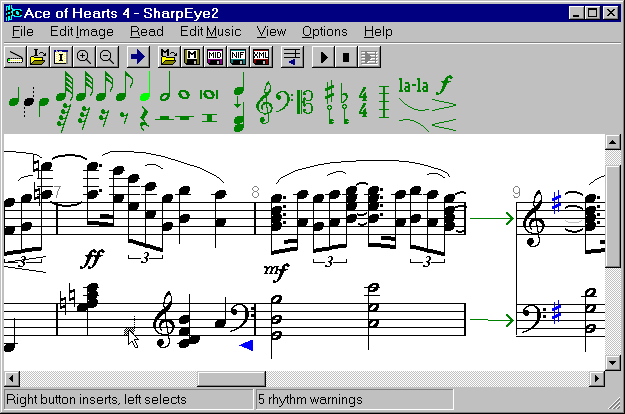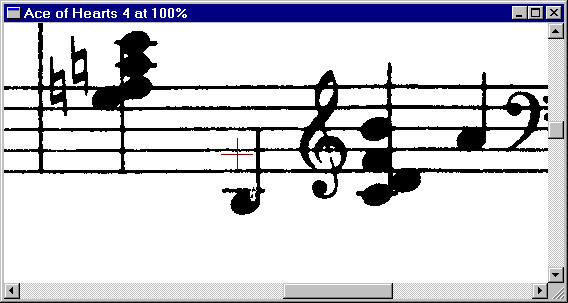
You need a computer with Windows 95, 98, ME, NT4, 2000, XP or Vista. A Pentium II processor with 32MB RAM is a minimum so there should not be any problems on most computers. If you want to process large images such as orchestral scores or run other programs alongside SharpEye you'll probably need more than 32Mb RAM, or the system can become totally bogged down.
You will need a scanner to scan the printed music in.
Its not essential, but you will almost certainly want a music notation editor which imports one of the file formats that SharpEye exports (MIDI, NIFF, MusicXML, and its own format) or a MIDI sequencer, so that you can make use of the output from SharpEye. Windows/IE4 comes with a simple MIDI player so you can double click on the MIDI file saved from SharpEye and hear the result, but the music will all be played on a synthesised 'piano'. See below and also the links page for programs to use with SharpEye.


SharpEye Music Reader converts a scanned image of printed music into a MIDI file, a NIFF file, or a MusicXML file. It allows direct scanning from TWAIN compatible scanners. (Most scanners are TWAIN compatible).
Used at its simplest, you drag an image file into a window, click on a button and wait for the conversion to take place. The output is shown in conventional music notation in another window. Click on another button to save the result as a MIDI file.
Usually there will be some errors in the output: SharpEye has a built in editor for correcting them. Almost all the editing can be done with the mouse and delete key. The input image window automatically scrolls to the right place in the image as you edit. SharpEye also shows warnings for each bar which doesn't make musical sense. This acts a bit like a spellchecker and directs your attention to likely errors.
SharpEye does not cope with handwritten music.
SharpEye does not have facilities for transposing or printing the music. You can either: use SharpEye with a notation editor (see below), or use Music Publisher + MP Scan. See the links page for more details about Music Publisher + MP Scan.
The short answer is: MIDI sequencers and music notation editors.
MIDI sequencers are oriented towards sound output (though some also print) while music notation programs are oriented towards printed output (though most will play the music).
If you use a MIDI sequencer with SharpEye you will export the score from SharpEye as a MIDI file and import it into the sequencer. You will lose some information about how the music is laid out. If you are mainly interested in the sound, this may not worry you, but if you intend printing the music again, it is far from ideal.
If you use a notation editor, you should if possible choose one which imports either NIFF or MusicXML format. Most of the major notation editors now provide an import facility for at least one of these.
See the links page for more details about suitable notation editors.
It is very difficult to convey how accurate SharpEye is in words. I have always given accuracy the top priority during the development of SharpEye, and according to reviews and existing customers, SharpEye v1 was already one of the most accurate music OCRs in the world. Version 2 is significantly better.
But I don't expect you to take my word: try SharpEye, try others, make up your own mind.
SharpEye 2 costs $169 (USD). You can upgrade from v1 to v2 for the price difference, ie $119. These are the prices you will be charged if you buy SharpEye over the internet by clicking one of the "Register" buttons on the home page.
There are also other ways to pay. If you are in the UK it may be cheaper to post me a cheque, depending on the exchange rate. There are also several SharpEye distributors (see the links page) who may sell at different prices, or bundle SharpEye with other products, and so on.
Version 2 is more accurate, meaning you spend less time correcting errors. The more you use SharpEye the more you will appreciate this.
Version 2 recognises more symbols. It recognises dynamics (ppp...fff) and hairpins, grace notes, chords and beamed groups that cross 2 or more staves, and accented characters in lyrics.
Version 2 has direct scanning from TWAIN-compatible scanners.
Version 2 has MusicXML export as well as NIFF and MIDI.
Version 2 has numerous enhancements to the music editor to speed up the correction and deal with more symbols.
If you would like more information before downloading and installing you can download SharpEye's manuals from the download page.